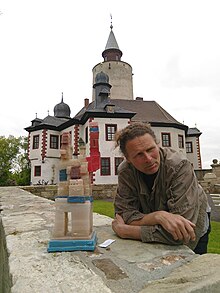German dust archive

The German Dust Archive is a collection and documentation of international historical dusts that the Cologne artist and art historian Wolfgang Stöcker (* 1969 in Bergisch Gladbach ) is bringing together.
History and way of working
Since 2004, Stöcker has been pursuing the project of obtaining dust samples from all over the world. To do this, he himself travels to historically significant places to wipe the dust with his own hands; In addition, Stöcker sends letters in which he asks churches, ministries, museums and similar institutions to send them dust samples. Furthermore, “dust scouts” work on his behalf, who bring dust with them from their travels and make it available to the archive.
Art historian Stöcker sorts the archival material into six (originally three) categories:
- Sacred dust
- Culture dusts
- Political dusts (from places of any political power)
- Culinary dusts (preferably from wine cellars)
- Natural dust
- Musical dust
Some of them come from historically significant areas such as For example, from the Acropolis , from the Cologne Cathedral , from the Wartburg in Eisenach , from the Louvre in Paris , from the Great Wall of China , from the Colosseum in Rome , from the desert city of Petra in Jordan , from the Sydney Opera House and from the Drachenfels in Koenigswinter .
The holdings of the first and only dust archive (as of May 2019: around 600 samples) are collected by Wolfgang Stöcker in files and stored on a shelf in his Cologne apartment.
Self-image
In response to his letters, Stöcker received a wide range of reactions such as incomprehension ( Federal President's Office ), silence ( Limburg Cathedral ) and accommodating ( Erfurt Cathedral ). Originally planned and created as a pure art project (instead of a planned cobweb archive and as a successor to a water archive), Stöcker is increasingly understanding work on the archive. Quote: "Over time, the wink has become more serious ..." ; now the artist's work is also about "... to visualize the presence of decay" . In addition to the archive, Stöcker now offers dust excursions to places of urban decay in Cologne.
Exhibitions
- Siegen, Art Gallery (Helga Oberkalkofen) from May 7, 2011
- Bonn: The Mineralogical Museum of the Rheinische Friedrich-Wilhelms-Universität Bonn in Poppelsdorf Castle as part of the Steinmann Institute for Geology, Mineralogy and Paleontology will be presented from November 3, 2011 to November 4, 2012 in a special exhibition entitled "Vom Stein zum Dust "Parts of the German Dust Archive.
- Siegburg, City Museum (November 6th to December 15th, 2013)
- Cologne, City Museum : Under Cologne Roofs - Cologne Dust as Object Art and Photography (March 11 to June 25, 2016)
- Posterstein, Museum Burg Posterstein [1] : On the essence of dust - Dust expeditions to Burg Posterstein with Wolfgang Stöcker, Cologne (May 19 to August 18, 2019)
literature
- Gerd Michalek: Only dust in the wind? Or: visiting the dust collector . In: Deutschlandradio Kultur from August 31, 2005
- Irmine Skelnik: Museum of Contemporary Art: "Dust is the opposite of meaning" . In: The West, April 15, 2011,
- zel: Wolfgang Stöcker collects dust. "Magnificent leveler" . In: Siegener Zeitung, April 15, 2011
- Klaus Hofmann (Ed.): To the essence of dust. Dust expeditions to Posterstein Castle with Wolfgang Stöcker , Posterstein 2019.
Web links
- Homepage of the German Dust Archive
- Special exhibition "From stone to dust" in the Mineralogical Museum in Bonn
- German Dust Archive in Cologne: More than just piles: Dust sample three, Great Wall of China: Just a small pile of dirt? . Photo gallery in: Spiegel Online, February 7, 2011
- Interview from Radio Köln with Wolfgang Stöcker (with several original sounds)
- "Der Abstauber", WDR-TV: west.art from April 26, 2011 (video). Archived from the original on May 4, 2011 ; Retrieved July 10, 2015 .
- German Dust Archive Cologne . In: Germany news from the German representations in the USA, February 28, 2011
Individual evidence
- ↑ German Dust Archive in Cologne-Give me your content, Sucker !; Der Spiegel, February 7, 2011
- ↑ Crazy fascination - You have never seen what this Cologne man makes out of dust. Express Cologne, May 17, 2019, accessed on May 17, 2019 .
- ^ Expedition Colonia - Dust Expedition in Cologne Cathedral; Blog from March 22, 2010
- ↑ Wolfgang Stöcker - The German Dust Archive as a guest in the Art Gallery
- ^ District town of Siegburg Local from September 22, 2013: Dust dry? You bet! Wollmaus from Cologne Cathedral on the way to the City Museum , accessed on November 6, 2013

